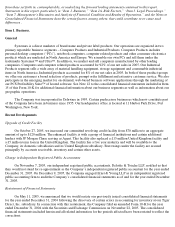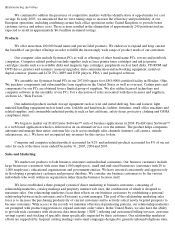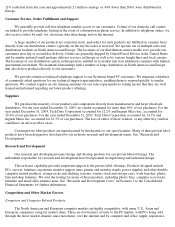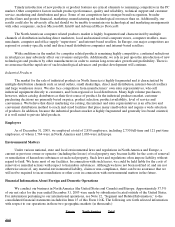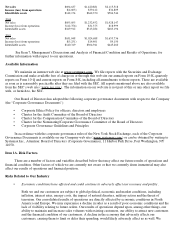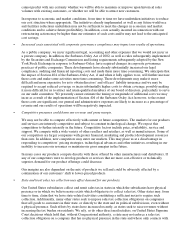Circuit City 2005 Annual Report Download - page 13
Download and view the complete annual report
Please find page 13 of the 2005 Circuit City annual report below. You can navigate through the pages in the report by either clicking on the pages listed below, or by using the keyword search tool below to find specific information within the annual report.We have been late in the filing of our 2005 quarterly and annual reports required under the Securities
Exchange Act of 1934. We expect that the first two quarterly reports for 2006 will also be filed late. Failure
to file our annual report on a timely basis could result in the de-listing of the Company’s common stock by
the New York Stock Exchange. If we do not file our required annual and quarterly financial statements in
the prescribed time frames we would also be ineligible to file certain registration statements and could be
subject to SEC enforcement action.
• Our success is dependent upon the availability of credit and financing.
We require significant levels of capital in our business to finance accounts receivable and inventory. We
maintain credit facilities in the United States and in Europe to finance increases in our working capital if
available cash is insufficient. The amount of credit available to us at any point in time may be adversely
affected by the quality or value of the assets collateralizing these credit lines. In addition, if we are unable
to renew or replace these facilities at maturity our liquidity and capital resources may be adversely affected.
However, we have no reason to believe that we will not be able to renew or replace our facilities when they
reach maturity.
• We have substantial international operations and we are exposed to fluctuations in currency exchange
rates and political uncertainties.
We operate internationally and as a result, we are subject to risks associated with doing business globally.
Risks inherent to operating overseas include:
•
•
•
•
Changes in a country's economic or political conditions
Changes in foreign currency exchange rates
Difficulties with staffing and managing international operations
Unexpected changes in regulatory requirements
For example, we currently have operations located in nine countries outside the United States, and non-
U.S.
sales (Europe and Canada) accounted for 37.5% of our revenue during 2005. To the extent the U.S. dollar
strengthens against the Euro and British pound, our European revenues and profits will be reduced when
translated into U.S. dollars.
• Sales to individual consumers exposes us to credit card fraud, which could adversely affect our business.
Failure to adequately control fraudulent credit card transactions could increase our expenses. Increased
sales to individual consumers, which are more likely to be paid for using a credit card, increases our
exposure to fraud. We employ technology solutions to help us detect the fraudulent use of credit card
information. However, if we are unable to detect or control credit card fraud, we may in the future suffer
losses as a result of orders placed with fraudulent credit card data, which could adversely affect our
business.
• We are exposed to inventory risks.
A substantial portion of our inventory is subject to risk due to technological change and changes in market
demand for particular products. If we fail to manage our inventory of older products we may have excess or
obsolete inventory. We may have limited rights to return purchases to certain suppliers and we may not be
able to obtain price protection on these items. The elimination of purchase return privileges and lack of
availability of price protection could lower our gross margin or result in inventory write-downs.
We also take advantage of attractive product pricing by making opportunistic bulk inventory purchases;
any resulting excess and/or obsolete inventory that we are not able to re-sell could have an adverse impact
on our results of operations. Any inability to make such bulk inventory purchases may significantly impact
our sales and profitability.
• Our income tax rate and the value of our deferred tax assets are subject to change.




